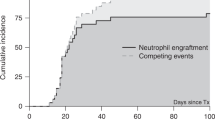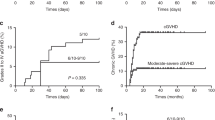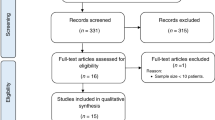Abstract
We conducted a retrospective analysis to evaluate outcomes of haploidentical transplantation in adult severe aplastic anaemia (SAA) patients. Fifty-one adults received haploidentical transplantation between May 2011 and December 2016. Patients were administered busulfan (Bu), cyclophosphamide (Cy) and anti-thymoglobulin (ATG) as conditioning regimens, followed by bone marrow and peripheral blood transplantation. The patients’ median age was 25 years. Forty-nine patients survived for more than 28 days and all achieved donor myeloid engraftment. The median time for myeloid engraftment and platelet recovery was 13 days (range, 10–21) and 17.5 (range, 7–101) days. The cumulative incidence (CI) of grade II–IV and III–IV acute GvHD) was 20.00±0.33% and 6.00±0.12%, respectively. The incidence of chronic GvHD was 14.00±0.36% and 25.90±0.71%, and that of moderate-severe chronic GvHD was 2.51±0.06% and 6.92±0.25% at 1 and 3 years, respectively. The 3-year estimated overall survival and failure-free survival were both 83.5±5.4% with a median follow-up of 21.1 months. Multivariate analysis showed hematopoietic cell transplantation-specific comorbidity index (HCT-CI) score of ⩾3 was significantly associated with worse outcome. Haploidentical transplantation conditioning including Bu/Cy/ATG was a safe and effective strategy for adult SAA patients, and HCT-CI might be an outcome predictor in these patients.
This is a preview of subscription content, access via your institution
Access options
Subscribe to this journal
Receive 12 print issues and online access
$259.00 per year
only $21.58 per issue
Buy this article
- Purchase on Springer Link
- Instant access to full article PDF
Prices may be subject to local taxes which are calculated during checkout

Similar content being viewed by others
References
Brodsky RA, Jones RJ . Aplastic anaemia. Lancet (London, England) 2005; 365: 1647–1656.
Scheinberg P, Young NS . How I treat acquired aplastic anemia. Blood 2012; 120: 1185–1196.
Marsh JC, Ball SE, Cavenagh J, Darbyshire P, Dokal I, Gordon-Smith EC et al. Guidelines for the diagnosis and management of aplastic anaemia. Br j haematol 2009; 147: 43–70.
Killick SB, Bown N, Cavenagh J, Dokal I, Foukaneli T, Hill A et al. Guidelines for the diagnosis and management of adult aplastic anaemia. Br j haematol 2016; 172: 187–207.
Dufour C, Pillon M, Socie G, Rovo A, Carraro E, Bacigalupo A et al. Outcome of aplastic anaemia in children. A study by the severe aplastic anaemia and paediatric disease working parties of the European group blood and bone marrow transplant. Br j haematol 2015; 169: 565–573.
Choi YB, Yi ES, Lee JW, Sung KW, Koo HH, Yoo KH . Immunosuppressive therapy versus alternative donor hematopoietic stem cell transplantation for children with severe aplastic anemia who lack an HLA-matched familial donor. Bone marrow transplant 2017; 52: 47–52.
DeZern AE, Zahurak M, Symons H, Cooke K, Jones RJ, Brodsky RA . Alternative donor transplantation with high-dose post-transplantation cyclophosphamide for refractory severe aplastic anemia. Biol blood and marrow transplant 2017; 23: 498–504.
Kim H, Lee JH, Joo YD, Bae SH, Lee SM, Jo JC et al. Comparable allogeneic hematopoietic cell transplantation outcome of a haplo-identical family donor with an alternative donor in adult aplastic anemia. Acta haematol 2016; 136: 129–139.
Xu LP, Liu KY, Liu DH, Han W, Chen H, Chen YH et al. A novel protocol for haploidentical hematopoietic SCT without in vitro T-cell depletion in the treatment of severe acquired aplastic anemia. Bone marrow transplant 2012; 47: 1507–1512.
Im HJ, Koh KN, Choi ES, Jang S, Kwon SW, Park CJ et al. Excellent outcome of haploidentical hematopoietic stem cell transplantation in children and adolescents with acquired severe aplastic anemia. Biol blood marrow transplant 2013; 19: 754–759.
Gao L, Li Y, Zhang Y, Chen X, Gao L, Zhang C et al. Long-term outcome of HLA-haploidentical hematopoietic SCT without in vitro T-cell depletion for adult severe aplastic anemia after modified conditioning and supportive therapy. Bone marrow transplant 2014; 49: 519–524.
Wang Z, Zheng X, Yan H, Li D, Wang H . Good outcome of haploidentical hematopoietic SCT as a salvage therapy in children and adolescents with acquired severe aplastic anemia. Bone marrow transplant 2014; 49: 1481–1485.
Clay J, Kulasekararaj AG, Potter V, Grimaldi F, McLornan D, Raj K et al. Nonmyeloablative peripheral blood haploidentical stem cell transplantation for refractory severe aplastic anemia. Biol blood marrow transplant 2014; 20: 1711–1716.
Esteves I, Bonfim C, Pasquini R, Funke V, Pereira NF, Rocha V et al. Haploidentical BMT and post-transplant Cy for severe aplastic anemia: a multicenter retrospective study. Bone marrow transplant 2015; 50: 685–689.
Bacigalupo A . Bone marrow transplantation for acquired severe aplastic anemia. Hematol/oncol clin North Am 2014; 28: 1145–1155.
Xu LP, Wang SQ, Wu DP, Wang JM, Gao SJ, Jiang M et al. Haplo-identical transplantation for acquired severe aplastic anaemia in a multicentre prospective study. Br j haematol 2016; 175: 265–274.
Xu LP, Jin S, Wang SQ, Xia LH, Bai H, Gao SJ et al. Upfront haploidentical transplant for acquired severe aplastic anemia: registry-based comparison with matched related transplant. J hematol oncol 2017; 10: 25.
Bacigalupo A, Hows J, Gluckman E, Nissen C, Marsh J, Van Lint MT et al. Bone marrow transplantation (BMT) versus immunosuppression for the treatment of severe aplastic anaemia (SAA): a report of the EBMT SAA working party. Br j haematol 1988; 70: 177–182.
Kojima S, Matsuyama T, Kato S, Kigasawa H, Kobayashi R, Kikuta A et al. Outcome of 154 patients with severe aplastic anemia who received transplants from unrelated donors: the Japan Marrow Donor Program. Blood 2002; 100: 799–803.
Ades L, Mary JY, Robin M, Ferry C, Porcher R, Esperou H et al. Long-term outcome after bone marrow transplantation for severe aplastic anemia. Blood 2004; 103: 2490–2497.
Passweg JR, Perez WS, Eapen M, Camitta BM, Gluckman E, Hinterberger W et al. Bone marrow transplants from mismatched related and unrelated donors for severe aplastic anemia. Bone marrow transplant 2006; 37: 641–649.
Lee JW, Cho BS, Lee SE, Eom KS, Kim YJ, Kim HJ et al. The outcome of unrelated hematopoietic stem cell transplants with total body irradiation (800cGy) and cyclophosphamide (120 mg/kg) in adult patients with acquired severe aplastic anemia. Biol blood marrow transplant 2011; 17: 101–108.
Maury S, Bacigalupo A, Anderlini P, Aljurf M, Marsh J, Socie G et al. Improved outcome of patients older than 30 years receiving HLA-identical sibling hematopoietic stem cell transplantation for severe acquired aplastic anemia using fludarabine-based conditioning: a comparison with conventional conditioning regimen. Haematologica 2009; 94: 1312–1315.
Camitta BM, Thomas ED, Nathan DG, Santos G, Gordon-Smith EC, Gale RP et al. Severe aplastic anemia: a prospective study of the effect of early marrow transplantation on acute mortality. Blood 1976; 48: 63–70.
Huang XJ, Liu DH, Liu KY, Xu LP, Chen H, Han W et al. Haploidentical hematopoietic stem cell transplantation without in vitro T-cell depletion for the treatment of hematological malignancies. Bone marrow transplant 2006; 38: 291–297.
Xiao-Jun H, Lan-Ping X, Kai-Yan L, Dai-Hong L, Huan C, Wei H et al. HLA-mismatched/haploidentical hematopoietic stem cell transplantation without in vitro T cell depletion for chronic myeloid leukemia: improved outcomes in patients in accelerated phase and blast crisis phase. Ann med 2008; 40: 444–455.
Przepiorka D, Weisdorf D, Martin P, Klingemann HG, Beatty P, Hows J et al. 1994 consensus conference on acute GVHD grading. Bone marrow transplant 1995; 15: 825–828.
Filipovich AH, Weisdorf D, Pavletic S, Socie G, Wingard JR, Lee SJ et al. National Institutes of Health consensus development project on criteria for clinical trials in chronic graft-versus-host disease: I. Diagnosis and staging working group report. Biol blood marrow transplant 2005; 11: 945–956.
Bearman SI, Appelbaum FR, Buckner CD, Petersen FB, Fisher LD, Clift RA et al. Regimen-related toxicity in patients undergoing bone marrow transplantation. J clin oncol 1988; 6: 1562–1568.
Sorror ML, Maris MB, Storb R, Baron F, Sandmaier BM, Maloney DG et al. Hematopoietic cell transplantation (HCT)-specific comorbidity index: a new tool for risk assessment before allogeneic HCT. Blood 2005; 106: 2912–2919.
Bacigalupo A, Hows J, Gordon-Smith EC, Gluckman E, Van Lint MT, Congiu M et al. Bone marrow transplantation for severe aplastic anemia from donors other than HLA identical siblings: a report of the BMT Working Party. Bone marrow transplant 1988; 3: 531–535.
Wagner JL, Deeg HJ, Seidel K, Anasetti C, Doney K, Sanders J et al. Bone marrow transplantation for severe aplastic anemia from genotypically HLA-nonidentical relatives. An update of the Seattle experience. Transplantation 1996; 61: 54–61.
Im HJ, Koh KN, Seo JJ . Haploidentical hematopoietic stem cell transplantation in children and adolescents with acquired severe aplastic anemia. Kor j pediatr 2015; 58: 199–205.
Gupta V, Eapen M, Brazauskas R, Carreras J, Aljurf M, Gale RP et al. Impact of age on outcomes after bone marrow transplantation for acquired aplastic anemia using HLA-matched sibling donors. Haematologica 2010; 95: 2119–2125.
Shin SH, Jeon YW, Yoon JH, Yahng SA, Lee SE, Cho BS et al. Comparable outcomes between younger (40 years) and older (>40 years) adult patients with severe aplastic anemia after HLA-matched sibling stem cell transplantation using fludarabine-based conditioning. Bone marrow transplant 2016; 51: 1456–1463.
Sorror ML, Sandmaier BM, Storer BE, Maris MB, Baron F, Maloney DG et al. Comorbidity and disease status based risk stratification of outcomes among patients with acute myeloid leukemia or myelodysplasia receiving allogeneic hematopoietic cell transplantation. J clin oncol 2007; 25: 4246–4254.
Saad A, Mahindra A, Zhang MJ, Zhong X, Costa LJ, Dispenzieri A et al. Hematopoietic cell transplant comorbidity index is predictive of survival after autologous hematopoietic cell transplantation in multiple myeloma. Biol blood marrow transplant 2014; 20: 402–408.e401.
Mo XD, Xu LP, Liu DH, Zhang XH, Chen H, Chen YH et al. The hematopoietic cell transplantation-specific comorbidity index (HCT-CI) is an outcome predictor for partially matched related donor transplantation. Am j hematol 2013; 88: 497–502.
Luo XH, Chang YJ, Xu LP, Liu DH, Liu KY, Huang XJ . The impact of graft composition on clinical outcomes in unmanipulated HLA-mismatched/haploidentical hematopoietic SCT. Bone marrow transplant 2009; 43: 29–36.
Chang YJ, Xu LP, Wang Y, Zhang XH, Chen H, Chen YH et al. Controlled, randomized, open-label trial of risk-stratified corticosteroid prevention of acute graft-versus-host disease after haploidentical transplantation. J clin oncol 2016; 34: 1855–1863.
Acknowledgements
This work was partly supported by Collaborative Innovation Centre of Haematology China, National Natural Science Foundation of China (Grant No. 81230013 and 81370666) and Beijing Municipal Science & Technology Commission (No. Z141100000214011 and Z151100001615020). We thank all colleagues for participating in this research.
Author information
Authors and Affiliations
Corresponding author
Ethics declarations
Competing interests
The authors declare no conflict of interest.
Additional information
Supplementary Information accompanies this paper on Bone Marrow Transplantation website
Supplementary information
Rights and permissions
About this article
Cite this article
Xu, LP., Xu, ZL., Wang, FR. et al. Unmanipulated haploidentical transplantation conditioning with busulfan, cyclophosphamide and anti-thymoglobulin for adult severe aplastic anaemia. Bone Marrow Transplant 53, 188–192 (2018). https://doi.org/10.1038/bmt.2017.237
Received:
Revised:
Accepted:
Published:
Issue Date:
DOI: https://doi.org/10.1038/bmt.2017.237
This article is cited by
-
Meta-analysis of the results of haploidentical transplantation in the treatment of aplastic anemia
Annals of Hematology (2023)
-
A novel TBI free conditioning protocol for haploidentical transplant in acquired aplastic anemia: (FluCAB-Prime)
Bone Marrow Transplantation (2021)
-
Haploidentical stem cell transplantation for aplastic anemia: the current advances and future challenges
Bone Marrow Transplantation (2021)
-
Successful haploidentical transplantation using plasma exchange and post-transplantation cyclophosphamide for severe aplastic anemia patients with anti-human leukocyte antigen donor-specific antibodies
Annals of Hematology (2021)
-
Posttransplant cyclophosphamide in allogeneic bone marrow transplantation for the treatment of nonmalignant hematological diseases
Bone Marrow Transplantation (2020)



